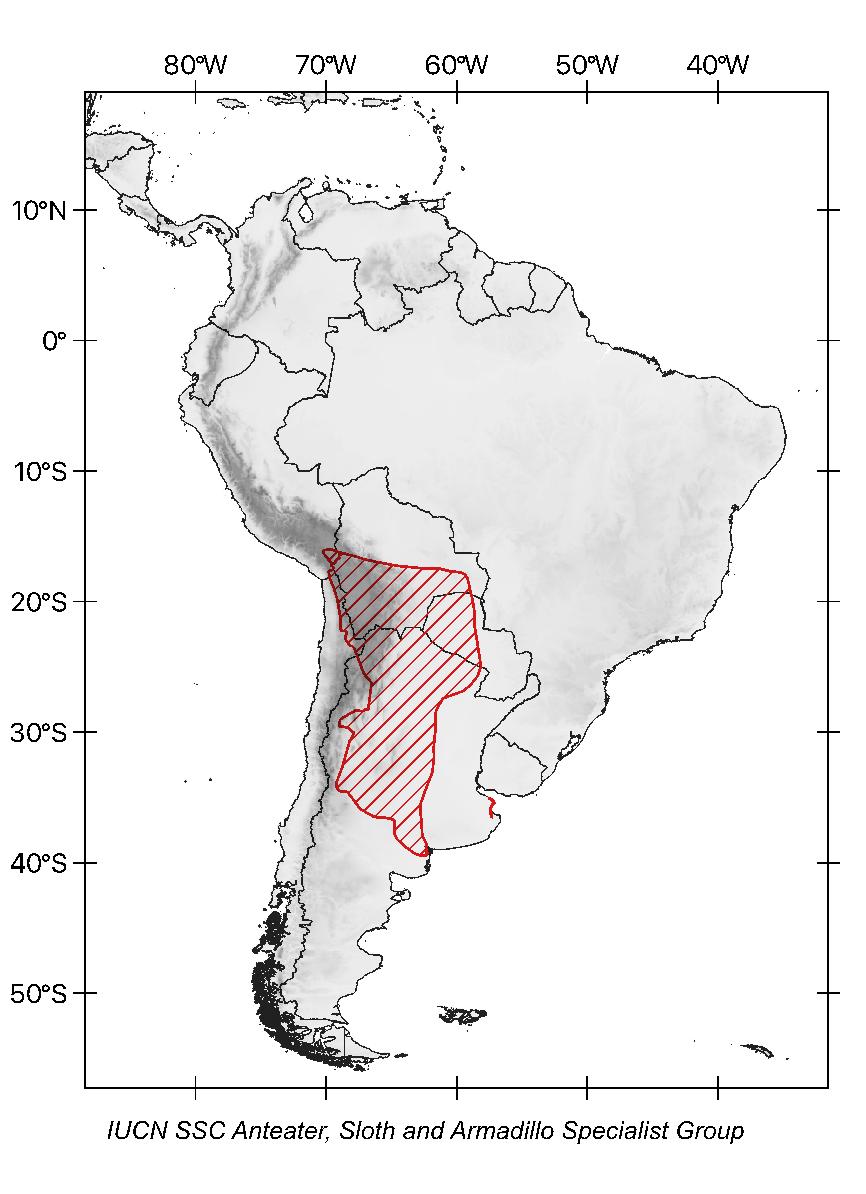Screaming hairy armadillo
(Chaetophractus vellerosus)
other common names
Lesser hairy armadillo
Small hairy armadillo
Andean hairy armadillo
Taxonomy
Order: Cingulata
Family: Chlamyphoridae
Subfamily: Euphractinae


description
The screaming hairy armadillo is a relatively small species, and the smallest of all Euphractinae. It weighs around 0.6 to 1.2 kg and has a head-body length of 20 to 30 cm. Its carapace has 6 to 8 movable bands and 1 or 2 small openings for pelvic glands in the mid-dorsal line of the pelvic shield. It can be brown or pale tan and is covered with comparatively dense hair. A notable aspect of screaming hairy armadillos are its proportionally long ears, which can measure up to 3.2 cm in length. Until 2015, Chaetophractus nationi was classified as a separate species although its taxonomic validity had already been questioned in the 1980s. Recent morphological and molecular studies of hairy armadillos confirmed that there are not enough differences between C. nationi and C. vellerosus to classify them as separate species. As a consequence, both species were synonymized, which means that both C. nationi and C. vellerosus are now considered the same species, named Chaetophractus vellerosus.

diet
This is a carnivorous-omnivorous species that eats primarily arthropods (mainly beetle adults and larvae), plant material, small vertebrates, and other invertebrates. The diet may vary seasonally, with a higher insect consumption during the drier summer months and more plant material in winter. Screaming hairy armadillos produce highly concentrated urine as an adaptation to living in desert environments, where water is not easily available.

HaBITAT and ECOLOGy
This species prefers xeric (dry) areas. It is common in rangelands, pastures, and agricultural areas, and avoids areas with poorly drained soils. Screaming hairy armadillos are solitary, except for juvenile littermates and during mating season. Home ranges vary between 0.23 and 5.3 hectares. In some areas, screaming hairy armadillos are active at night during summer and diurnal in winter to avoid extreme temperatures. They seem to be active during the day all year round at high elevations. This species prefers to dig burrows in areas with sandy and calcareous soils. The burrows can be several meters long and up to 2 meters deep. The average life expectancy has been estimated at approximately 3 years, and maximum longevity is 6 to 10 years.

reproduction
Males and females become sexually mature at around 11 months of age. Screaming hairy armadillos are seasonal breeders that initiate the mating period between the end of winter and the beginning of spring. One or two offspring are born inside the burrow after a gestation period of 60 days; they remain inside the burrow during most of the lactation period. Females produce a single litter per year.

curious facts
The common name of this species is related to its high-amplitude distress call when captured by predators or disturbed by humans. Its loud weeping calls are composed of five note types: crying, inhaled, inhaled sobbing, exhaled sobbing, and grunt notes.

threats
The screaming hairy armadillo is heavily hunted for its meat and carapace (including for charangos, a musical instrument, and matracas or maracas), in Bolivia in some parts of the Chaco region. It is also persecuted as an agricultural pest. In addition, some individuals are killed by hunting dogs and by cars on roads. The isolated population on the coast of Buenos Aires Province, Argentina, is negatively affected by mining activities. The species also suffers from habitat loss from sand excavation for concrete production and agricultural activities. Individuals living at high altitudes of Bolivia (previously considered to be Chaetophractus nationi) are negatively affected by the intense use to make handicrafts. Cáceres (1995) estimated that 2,000 individuals are harvested each year for this purpose. Illegal trade from Chile to Bolivia as well as within Bolivia has been reported and seems to be related to the reduction of the subpopulation near Oruro and the resulting difficulties to obtain animals for handicraft production. Although the extent of this illegal trade has not been quantified, it is suspected to negatively affect the local population.

range
Screaming hairy armadillos occur from Bolivia, northeastern Chile, and Paraguay south to southwestern Buenos Aires province in Argentina, at altitudes between sea level and approximately 4600 m asl. There is a disjunct population in eastern Buenos Aires province, which is separated from the main distribution area by around 500 km. Its presence in southeastern Peru is uncertain.

Population trend
Stable.

conservation status
Chaetophractus vellerosus is listed as Least Concern as, although susceptible to hunting in parts of its range, it is widespread and rates of offtake are not believed to be at a level that would warrant listing in a threatened category. However, there are two subpopulations that need major attention: one in the east of Buenos Aires Province (Argentina; locally assessed as Endangered), which is disjunct and subjected to habitat modification in its restricted range; and the other in Oruro department (Bolivia), which apparently is not disjunct and is intensely harvested and used to manufacture charangos (traditional music instruments), matracas or maracas (rattles), and handicrafts such as amulets and souvenirs.
Roughly 60% of the Bolivian range corresponds to the range of the high-altitude population previously known as C. nationi. Peredo (1999) reported 20 years ago that increasing difficulties in finding “quirquinchos” in the wild had led artisans from the region of Oruro and La Paz to start using C. vellerosus individuals. Because Municipal Bylaw 31/99 in Oruro did not succeed in reducing the use of Chaetophractus carapaces in traditional dances during the carnival, it is probable that the impact of hunting is increasingly affecting both the high-altitude (formerly C. nationi) and southern (C. vellerosus) subpopulations of Bolivia. In addition, illegal trade of specimens from Chile to Bolivia has been reported. This potential threat to the Chilean subpopulation should be closely monitored. The genetic data published by Abba et al. (2015) indicate that Chaetophractus specimens from high-altitudes of Bolivia share a unique mitochondrial haplotype, which is also found in a C. vellerosus specimen from Argentina. This absence of genetic diversity observed in the 10 individuals sampled within the Oruro region suggests a local reduction of effective population size. There is therefore no doubt that the synonymized C. vellerosus would have to be listed in a threatened category—either Vulnerable or Endangered—within Bolivia and that conservation measures should be implemented as soon as possible to save the species from regional extinction.